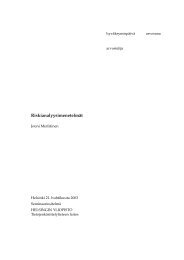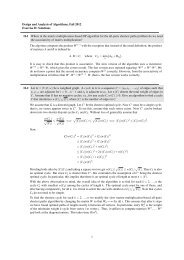Calculating trust in sensor networks
Calculating trust in sensor networks
Calculating trust in sensor networks
Create successful ePaper yourself
Turn your PDF publications into a flip-book with our unique Google optimized e-Paper software.
A malicious node may refuse to forward all or some packets that it receives. This is known<br />
as a blackhole or a greyhole-attack. These attacks work if the attacker is able to <strong>in</strong>ject<br />
itself <strong>in</strong>to a route.<br />
A s<strong>in</strong>khole is a node that tries to lure all possible routes to itself by advertis<strong>in</strong>g itself as a<br />
very high-quality candidate to other nodes. A laptop that disguises itself as a node may<br />
use a high-powered radio to advertise itself to the whole network. As most communications<br />
from the network are towards the s<strong>in</strong>k-node, a s<strong>in</strong>khole can effectively take over the network<br />
by advertis<strong>in</strong>g itself as the best candidate for rout<strong>in</strong>g packets to the s<strong>in</strong>k. A malicious<br />
node may also launch a sybil-attack, <strong>in</strong> which it disguises itself as several nodes.<br />
An attacker may also launch a wormhole-attack on the network. A wormhole occurs when<br />
the traffic of one part of the network is relayed by a low-latency l<strong>in</strong>k to another part of<br />
the network. This can effectively create a s<strong>in</strong>khole s<strong>in</strong>ce the attacker is able to create a<br />
shorter connection to the s<strong>in</strong>k from a distant part of the network.<br />
An attacker can also spoof l<strong>in</strong>k layer acknowledgements for overheard packets. This can<br />
be used to advertise a weak l<strong>in</strong>k as a strong l<strong>in</strong>k, or a dead node as a live node.<br />
A method of combat<strong>in</strong>g some of these attacks is us<strong>in</strong>g l<strong>in</strong>k-layer encryption. This effectively<br />
elim<strong>in</strong>ates all but the wormhole-attack [KW03]. Wormholes may be detected by some<br />
methods, for <strong>in</strong>stance geographic rout<strong>in</strong>g protocols can notice if a route advertised through<br />
a wormhole is well above their normal transmission ranges.<br />
Eventually, if a node is compromised and the attacker gets around any possible encryption<br />
or authentication mechanisms, there exists no possible way to counter any of the attacks<br />
described above. The follow<strong>in</strong>g chapter will give one possible solution to the problem of<br />
compromised nodes, distributed <strong>trust</strong> management.<br />
2.5 Summary<br />
Sensor <strong>networks</strong> are ad hoc wireless <strong>networks</strong> formed by very small autonomous sens<strong>in</strong>g<br />
devices. These <strong>sensor</strong>s typically conta<strong>in</strong> a radio, a CPU, a small amount of memory and<br />
run some sort of an embedded operat<strong>in</strong>g system complete with their on network stacks.<br />
16
















